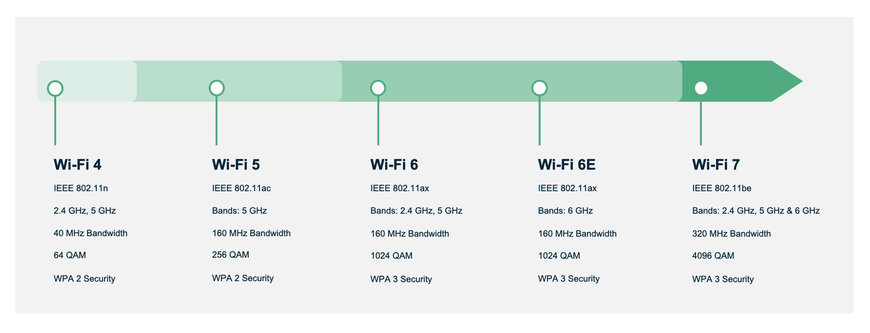www.industryemea.com
23
'23
Written on Modified on
Wi-Fi 7: Examining its Features and Benefits for Public Transport
Since the creation of the first 802.11 standard back in 1997, Wi-Fi has evolved to meet the increasing global demands for faster, more reliable, and efficient wireless connectivity.

Wi-Fi 7, also known as the IEEE 802.11be or the EHT (Extremely High Throughput) standard, marks a pivotal step change; its introduction will deliver far better performance in high-density environments, making it perfectly suited for public transport Wi-Fi use.
Ready to Revolutionise the Wireless Landscape
The recently announced Icomera A2 access point leverages the key advancements of Wi-Fi 7 to provide significantly improved performance for both connected passengers and onboard systems. In this article, we’ll delve into some of the technical aspects of Wi-Fi 7, and how these translate into various real-world benefits when it comes to public transportation applications specifically.
In a nutshell, Wi-Fi 7 is capable of delivering up to 4.8x faster speeds, double the maximum bandwidth, a 20% increase in data transmission, and up to 100x lower latency than previous generations of Wi-Fi standard.

Wi-Fi 7 Key Features Explained
With Wi-Fi 7, passengers travelling can experience faster web browsing, streaming, downloads, and video conferencing, helping ensure seamless connectivity throughout their journey. Several core technical features of Wi-Fi 7 facilitate this, a few of which I’ll focus on below…
Wider Channel Bandwidth
Wi-Fi 7 more than doubles the available usable bandwidth compared to Wi-Fi 6/6E by utilising 320 MHz channels on the dedicated 6 GHz band, in addition to being able to aggregate the 5 and 6 GHz spectrum (see the “Multi-Link Operation” section below), resulting in dramatically higher throughout.
To use an analogy, imagine Wi-Fi channels as being like vehicles carrying data packets along a road, with larger Wi-Fi channels represented by larger vehicles which can carry more data at once. Since Wi-Fi 7 can transport more data in a given period of time, those data packets are able to reach their destination more quickly.
4K QAM

Quadrature Amplitude Modulation (QAM) is a method used in communication to encode data by varying both the amplitude and phase of a signal, allowing more data to be transmitted at the same time. In basic terms, the higher the QAM, the more information can be transmitted.
Utilising 4K QAM, Wi-Fi 7 allows the data to be packed more densely compared to the 1K QAM of Wi-Fi 6/6E. Specifically, 4K QAM enables each symbol to carry 12 bits compared to 10 bits in Wi-Fi 6/6E; this results in 20% higher theoretical transmission rates. To continue with the analogy above, Wi-Fi 7’s higher QAM is like the cargo being loaded onto vehicles in a more effective way, so that more can be transported in a single trip.
Multi-Link Operation (MLO)
Whereas all previous Wi-Fi generations only establish single-band connections between devices, Multi-Link Operation (MLO), a new feature of Wi-Fi 7, allows devices to simultaneously send and receive data across different frequency bands and channels. This allows for a single user to use more of the available spectrum, delivering data at a greater speed and lower latency.
Preamble Puncturing
Preamble puncturing avoids channels with interference, resulting in the ability to use wider channels in high-density environments such as train carriages.
Without preamble puncturing, any channels with interference would become unavailable. Preamble puncturing allows you to surgically slice off only the part of the channel with interference, greatly improving network capacity and reducing network congestion.
Wi-Fi 7’s Specific Benefits for Public Transport
So, what do these features of Wi-Fi 7 translate to in terms of their benefits for public transportation in particular? How does the increased throughput and reduced latency that Wi-Fi 7 delivers benefit passengers and onboard systems on a train, for instance?
More Reliable Performance in Crowded Environments
Public transport vehicles are high-density environments, with many users seeking to stay connected simultaneously; this brings with it a unique set of connectivity challenges which must be overcome.
With previous Wi-Fi standards, technology and spectrum were a limiting factor which could sometimes lead to bottlenecks in crowded environments such as public transport vehicles. Wi-Fi 7 introduces a number of intelligent smart functions and features which allow for far better performance.
Each of the features we’ve looked at above helps play a role in facilitating seamless, reliable, resilient, and uninterrupted connectivity for large numbers of users.
Wider channel bandwidth means that more devices can be accommodated on the same channel. This increased channel capacity reduces congestion and interference, leading to more stable network performance.
By transmitting more data in each symbol, 4K QAM allows higher data rates to be achieved, leading to more efficient data transfer.
Since Multi-link Operation enables data to be sent across multiple channels simultaneously, reliability and redundancy on the network is improved, while latency is significantly reduced.
Pre-amble puncturing gives more usable spectrum in a high-density, high-interference environment.
Faster Speeds for Passengers and Onboard Systems
The Wi-Fi 7 standard is able to provide theoretical speeds up to 46 Gbps, a significant improvement on the maximum theoretical speed of 9.6 Gbps that Wi-Fi 6 offers. This loops back to the four features we have examined also:
With its wider channel bandwidth Wi-Fi 7 enables more data to be transmitted in any period of time, providing faster download and upload speeds.
4K QAM: Since Wi-Fi 7 efficiently encodes more data into each signal, data transmission efficiency in increased, resulting in faster data transfer rates for those connecting on a vehicle.
By enabling devices to simultaneously send and receive data over multiple radio bands as though they were a single, aggregated connection, Multi-link Operation helps lead to faster Internet speeds for connected users.
Though it does not increase the theoretical capacity, pre-amble puncturing greatly improves the usable spectrum / capacity to passengers.
Benefit from Next-generation Technology
By embracing Wi-Fi 7 using next-generation hardware such as the Icomera A2 access point, transport operators are best-equipped to future-proof their connectivity solution.
Adopting the latest Wi-Fi 7 standards allows transport operators to stay ahead of the curve; not only will they be ready to deliver faster and more reliable Internet access today, but they’ll also be prepared to meet the ever-increasing demands of any data-intensive applications which are introduced further down the line.
With all the exciting technological advancements that it brings, the likelihood is that Wi-Fi 7 will be one of the longer-lasting Wi-Fi standards, making it a future-proof investment.
Of course, Wi-Fi 7 is also backwards compatible with Wi-Fi 6/6E and all other earlier Wi-Fi standards; with the ability to cater to both new and legacy devices, transport operators can create a seamless connectivity experience for all passengers.
Leading the Wi-Fi 7 Way
As we’ve seen, the integration of Wi-Fi 7 capabilities within public transportation through products such as the Icomera A2 promises many advantages. The increased capacity and reduced latency that Wi-Fi 7 offers will help cater to the large numbers of connected devices in densely populated settings such as public transport vehicles.
Wi-Fi 7’s advanced features work together to improve network performance, reduce congestion, and make data transfer more efficient, resulting in faster speeds for passengers and onboard systems.
www.icomera.com

